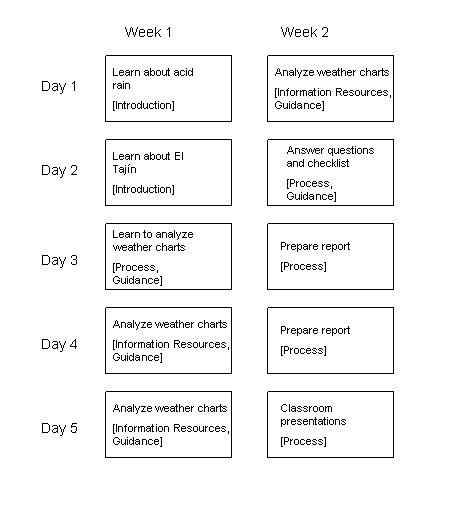This WebQuest provides an opportunity for students to integrate topics in science (acid rain) and social studies (ancient civilizations).
Students will learn about the meteorological and chemical components of acid rain, as well as its damaging effects to ancient monuments. The project involves research and reporting, web searching and data gathering, and interpretive reasoning. The project is designed as a group activity. The suggested evaluation rubric includes components for a student’s individual contribution, as well as for the group effort.
Grade level
This WebQuest is appropriate for grades 5-12. Teachers may wish to modify some of the tasks as appropriate for their classroom needs.
Objectives
At the end of this activity, students will have accomplished the following:
- gathered data using the web
- learned the basic chemical principles involved in acid rain
- learned how to analyze meteorological trajectory, cloud and precipitation charts
- performed a meteorological analysis using professional-quality weather data
- prepared individual and group reports using data gathered form the web
- referenced information sources
- collaboratively analyzed an environmental problem (the determination of acid rain sources)
- learned to make interpretations of scientific data
Interdisciplinary Opportunities
Links to Social Studies:
- Students can research the Totonac culture
- Students can compare Totonac culture with other Mesoamerican cultures, like the Mayas and the Aztecs
- Students, either individually or as a class, can write a letter to an elected official expressing their interest in reducing acid rain
- Teachers can use the webquest to catalyze interest in local issues, such as environmental pollution
Links to English Language Arts:
- Students can identify the audience and purpose for the report (described on the Process page)
Requirements
An Internet-connected computer.
Time
This project requires two weeks (approximately 50 minute periods each day).
- Week 1: gather background information on acid rain, begin to analyze weather charts
- Week 2: finish weather chart analysis, prepare reports
The following flowchart presents a suggested pathway for completing the project. The relevant webquest page is shown in brackets.

Other Ideas
If you wish to print any of the webquest pages, it may work better if you set your printer to print in landscape mode.
Standards
This WebQuest specifically addresses the following National Science Education Standards, but may also touch on other standards not listed:
Science as Inquiry – Content Standard A
- Use appropriate tools and techniques to gather, analyze and interpret data.
- Think critically and logically to make the relationships between evidence and explanations.
- Recognize and analyze alternative explanations and predictions.
- Use mathematics in all aspects of scientific inquiry
- Understandings about scientific inquiry
Physical Science – Content Standard B
- Properties and changes of properties in matter
- Transfer of energy
Earth and Space Science – Content Standard D
- Structure of the earth system
- atmosphere
- clouds
- global patterns of atmospheric movement
Science and Technology – Content Standard E
- Developing student abilities and understandings
- straightforward activity with only a few well-defined ways to solve the problems involved
- only one or two science ideas involved in the task
- Implement a proposed design
- Understandings about science and technology
History and Nature of Science – Content Standard G
- Science as a human endeavor
- Nature of science
Connect with Other School Subjects – Program Standard B
- Emphasize student understanding through inquiry
- Connection with other school subjects
Coordination of Science and Mathematics – Program Standard C
- Develop and use tables, graphs and rules to describe situations
- Use statistical methods to describe, analyze, evaluate and make decisions
Access to Appropriate and Sufficient Resources – Program Standard D
- Access to the world beyond the classroom:
- use of professional-quality meteorological data
- multimedia information on ancient Mesoamerican civilizations
Source: National Science Education Standards, 1996, National Academy Press, Washington, DC, 262 pp., www.nas.edu.